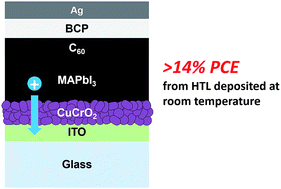
xululu91
Shared posts
[ASAP] Selective Heavy Atom Effect Forming Photosensitizing Hot Spots in Double-Stranded DNA Matrix
Drop‐Casting to Make Efficient Perovskite Solar Cells under High Humidity

MAPbI3 crystal growth in the films made by drop‐casting is regulated by changing the temperature. At low temperature (60 °C), the crystals are (110) oriented, needle‐like. At high temperature (>120 °C), the crystals are (200) oriented, presenting round grains. The different crystal growth mode leads to quite different film morphology and photovoltaic performance.
Abstract
Drop‐casting was used to make MAPbI3 films for solar cells. The crystal growth in drop‐cast MAPbI3 films was regulated by adjusting temperature. A mechanism for the formation of different morphology was proposed by combining in situ crystal‐growth study with XRD measurements. The crystals in the films made at low temperature (60 °C) and high temperature (≥120 °C) are (110) and (200) oriented, respectively. The different crystal growth mode leads to quite different film morphology. Compared with spin‐coating, drop‐casting shows much better tolerance to humidity. MAPbI3 solar cells made under 88 % humidity delivered a PCE of 18.17 %, which is the highest PCE for perovskite solar cells made under >70 % humidity without antisolvent assistance.
Sticky when dry
Nature Chemistry, Published online: 26 June 2020; doi:10.1038/s41557-020-0498-0
Is a nanoscale hydrophobic bowl wet or dry when dissolved in water? It turns out that the answer depends on the architecture of its rim. A molecular host decorated with four methyl groups around its rim pointing inward, rather than up, has now been shown to expel water from the bowl, making it dry and sticky.[ASAP] First-Principles Screening of All-Inorganic Lead-Free ABX3 Perovskites
xululu91IN
Influence of the Nature of A Cation on Dynamics of Charge Transfer Processes in Perovskite Solar Cells
xululu91Br
Abstract
The electronic processes occurring within the perovskite solar cells (PSCs) are strongly influenced by the nature of the organic A cations present within the inorganic framework. In this study, the impact of FA (CH(NH2)2+) and Cs+ cations on the intrinsic and interfacial properties in the FAPbBr3 and CsPbBr3 PSCs is investigated. The analysis of current density (JSC) and photovoltage (VOC) as a function of illumination intensity establishes that the interfacial charge transport is more rapid in FAPbBr3 devices. Small perturbation measurements including intensity modulated photocurrent and photovoltage spectroscopy are applied to explore the resistive and capacitive elements. Furthermore, electrochemical impedance spectroscopy measurements are found to correlate well with the photovoltaic characteristics of FAPbBr3 and CsPbBr3 PSCs. Overall, the in-depth analysis of various phenomena occurring within the bromide PSCs allows to underline the working principle, which provides a key to optimize the device performance. The present protocol is not only valid for PSCs but can also be extended to devices based on alternative light harvesters.

The effect of cations on the intrinsic and interfacial dynamic processes occurring in the perovskite solar cells is explored, which allow to underline their working principle.
Room-temperature fabrication of a delafossite CuCrO2 hole transport layer for perovskite solar cells
xululu91HTL
DOI: 10.1039/C7TA09494A, Paper
A delafossite CuCrO2 hole transport layer deposited at room temperature from a nanoparticle suspension is used in efficient perovskite cells.
The content of this RSS Feed (c) The Royal Society of Chemistry
Environmentally Friendly Solvent-Processed Organic Solar Cells that are Highly Efficient and Adaptable for the Blade-Coating Method
xululu917
Abstract
The power conversion efficiencies (PCEs) of state-of-the-art organic solar cells (OSCs) have increased to over 13%. However, the most commonly used solvents for making the solutions of photoactive materials and the coating methods used in laboratories are not adaptable for future practical production. Therefore, taking a solution-coating method with environmentally friendly processing solvents into consideration is critical for the practical utilization of OSC technology. In this study, a highly efficient PBTA-TF:IT-M-based device processed with environmentally friendly solvents, tetrahydrofuran/isopropyl alcohol (THF/IPA) and o-xylene/1-phenylnaphthalene, is fabricated; a high PCE of 13.1% can be achieved by adopting the spin-coating method, which is the top result for OSCs. More importantly, a blade-coated non-fullerene OSC processed with THF/IPA is demonstrated for the first time to obtain a promising PCE of 11.7%; even for the THF/IPA-processed large-area device (1.0 cm2) made by blade-coating, a PCE of 10.6% can still be maintained. These results are critical for the large-scale production of highly efficient OSCs in future studies.

Highly efficient non-fullerene organic solar cells (OSCs) are fabricated, processed with environmentally friendly solvents, tetrahydrofuran/isopropyl alcohol (THF/IPA) and o-xylene/1-phenylnaphthalene, respectively. The highest power conversion efficiency (PCE) of 13.1% can be achieved by adopting the spin-coating method, which is the top result for OSCs. When the blade-coating method is used in an ambient atmosphere, the THF/IPA-processed device maintains a high PCE of 11.7%.
Monolithic Wide Band Gap Perovskite/Perovskite Tandem Solar Cells with Organic Recombination Layers
xululu91a
Ploymer Solar Cells: Polymer Solar Cells Exceeding 10% Efficiency Enabled via a Facile Star-Shaped Molecular Cathode Interlayer with Variable Counterions (Adv. Funct. Mater. 26/2016)

On page 4643, Q. Peng and co-workers present a series of star-shaped small molecular cathode interlayer (CIL) materials for photovoltaic applications. They investigate how different pendant polar functionalities with or without mobile counterions influence the photovoltaic properties, including neutral amino groups, quaternary ammonium ions, amino N-oxide, and sulfobetaine ions. A high efficiency of 10.1%, preceding that of the PFN device, was achieved by using the CIL molecule with pendant quaternary ammonium ions.


